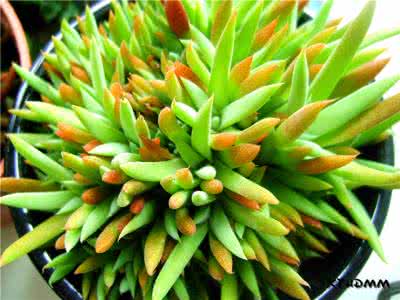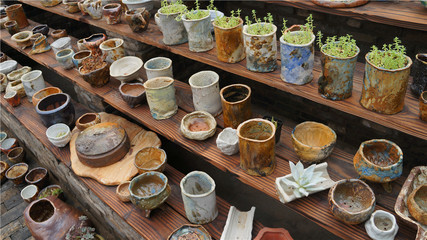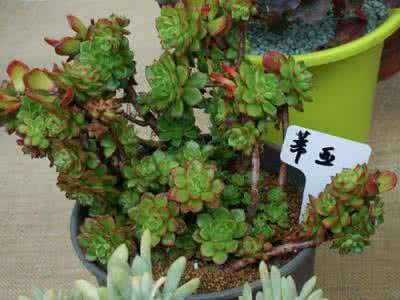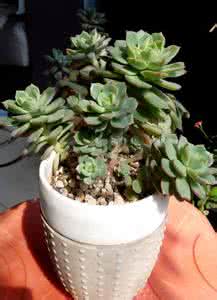讲如何养护植物的书本和文章实在太多了,这次我们只想简单地聊聊六点,都是我们认为对景天科的日常养护十分重要的方面,其中许多都是我们在照顾自己的花园和温室时总结出来的。
1. 日照与遮阴在景天科的自然栖息地中,极其强烈的日照十分有限。想要在人工条件下模拟这样的环境并不难,尤其是当你生活在温带,还有个温室的话。只有少数几种景天科植物能够忍受高温,因此当气温上升的时候,需要适当遮阴。如果你生活在热带,并且想要露养,那么需要避开毒辣的午后阳光。
2. 通风在自然环境下,风能够给被太阳烤热的土壤表面降温,而且效果显著。因此,通风十分重要,但温室很难模拟自然中的风。凝滞的空气和高湿度对于景天科来说是致命的组合,许多景天都因为真菌感染而自内而外地腐烂致死。高温和凝滞的空气也容易引起虫害,比如介壳虫爆发。
3. 浇水我们在管理露养和温室里的植物时发现,它们不太适应我们浇的水,在雨季时却状态奇佳。在美国仙肉协会(CSSA)的会刊上有篇连载的文章解答了这个怪现象。下面我们会用简单的文字和照片说说如何处理灌溉水,以及这样做的好处。
3.1 鉴定水源的ph值
第一步是要检测水源的ph值。我们买了一个电子检测仪,可以根据不同的溶液校准ph值。当然,你也可以租一个专业的实验仪器来确定水源的酸碱度。我们的水ph值高达8.2,太硬了,一点都不受植物根部的待见。这里提供一个比较:雨水通常偏酸性,ph值介于5.5到6.5之间。
3.2 将灌溉水的ph值修正到5.5
根据CSSA上那篇文章的建议,我们灌了一大桶114升(30加仑)的硬水,然后往里面兑便宜的白醋,试图降低其ph值。白醋一次只能添加一点,每次加完还要搅拌一下桶里的水,这样才能精确地量出加多少白醋可以把水的ph值修正到5.5。就我们自己的情况来说,300毫升(1又1/3杯)白醋兑114升(30加仑)水刚刚好。CSSA上那篇文章的作者建议尽快用完兑好的水,不然水的ph值会缓慢回升。因此,最好是用多少,兑多少。
3.3 添加硫酸铵
硫酸铵是农业中广泛应用的一种肥料,作用是保持植物的根系健康,提高根部吸收水分和养料的能力。我们习惯在114升(30加仑)的水中添加两平勺的硫酸铵。要先把硫酸铵溶解在1升的水中,然后再将这1升水兑入水桶并搅拌均匀。通常,市面上的硫酸铵为结晶体,价格很便宜。作为肥料应用的硫酸铵浓度会更高,但其中只有氮的成分,没有磷或钾。
3.4 实际效果
只消几天,植物看起来就更健壮了,有充沛的能量开花,而且抵御虫害的能力也更强。仅仅几周之后,差异便很明显了。现在,无论是露养还是温室我们都用这样配出来的水。
4. 用土我们用在花园里的介质是50%园土混合50%轻石,以提高土壤的排水性,并用红色火山石铺面,好减少阳光的蒸腾作用,避免水分流失过快。温室里我们则用30%的泥炭加70%的轻石,大粒花岗岩砂铺面。我们不推荐用纯园土,太肥了,会让植物徒长。
5. 肥料多肉施肥很容易徒长变形。我们私下和圣地亚哥的多肉种植专家Kelly Griffin聊过这个问题,最后达成的共识是10-20-20的氮磷钾肥必须稀释五倍后施用,或者类似浓度的肥料,每年不得使用超过两次,以免徒长。
6. 虫害"虫害"二字是每个景天爱好者心头的噩梦。最好用的是内吸杀虫药,可以通过植物的根部被吸收,使植株对虫子产生自发性的抗体。

希望这几条经验能够对你们成功养护多肉植物有所帮助。
源文直译
作者简介 Julia Etter和Martin Kristen是一对瑞士夫妻,自称为“瑞士环球旅行家”,现在定居在墨西哥中部,几乎游遍了北美洲的各个景天科植物原产地,给野生植物拍照片,建档案,还建了一个相对较全的景天科在线数据库,即http://www.crassulaceae.com/
作者 Julia Etter & Martin Kristen
翻译 Qiuhan
一切权利属于原作者,欢迎勘误。
谢谢美纱审阅化学相关部分^^
*本文由原译者Qiuhan授权由小岛向北代为转发。
**小岛向北仅仅对其中的格式有所重新编排与调整。
There are sufficient publications available where at least one chapter is dedicated to the adequate cultivation of plants. That's why we only would like to address six topics that we believe very important for the successfull cultivation of crassulaceae, or rather that we have noticed in our own garden and greenhouse work.
讲如何养护植物的书本和文章实在太多了,这次我们只想简单地聊聊六点,都是我们认为对景天科的日常养护十分重要的方面,其中许多都是我们在照顾自己的花园和温室时总结出来的。
1. Sun and Shade
1. 日照与遮阴
In their natural habitat most crassulaceae grow in locations where the influence of the sometimes extremely strong sun is limited. It is not very difficult to simulate this situation with plants in cultivation if you are living in moderate climate zones and cultivate your plants in a greenhouse. Only very few crassulaceae do well standing high temperatures that's why one has to work with shading cloth when temperatures rise too much in the greenhouse. If you have the possibility to grow crassulaceae outdoors and are living in hot climates, you should try to avoid the very hot afternoon sun.
在景天科的自然栖息地中,极其强烈的日照十分有限。想要在人工条件下模拟这样的环境并不难,尤其是当你生活在温带,还有个温室的话。只有少数几种景天科植物能够忍受高温,因此当气温上升的时候,需要适当遮阴。如果你生活在热带,并且想要露养,那么需要避开毒辣的午后阳光。
2. Wind
2. 通风
In nature wind has the capacity to considerably lower the surface temperature of plants in sunny locations. Wind is therefore very important, but it is difficult to accurately simulate in a greenhouse. Stagnant air and high humidity are a deadly combination for crassulaceae in cultivatiion. Most crassulaceae die because of fungi that let them rot slowly from the inside out. With high temperatures and stagnant air various pests such as mealy bugs can multiply explosively as well.
在自然环境下,风能够给被太阳烤热的土壤表面降温,而且效果显著。因此,通风十分重要,但温室很难模拟自然中的风。凝滞的空气和高湿度对于景天科来说是致命的组合,许多景天都因为真菌感染而自内而外地腐烂致死。高温和凝滞的空气也容易引起虫害,比如介壳虫爆发。
3. Water
3. 给水
In the cultivation of our plants (outdoors and greenhouse) we have discovered over the years that our plants had problems with our water but that they looked great again during the rainy season. An article in several parts in the journal of the American Cactus and Succulent Society had the answer to this mystery. In short words and a few pictures we would like to explain how we proceeded and what results the new watering system brought about. If you would like to know all of the details you should consult the entire article.
我们在管理露养和温室里的植物时发现,它们不太适应我们浇的水,在雨季时却状态奇佳。在美国仙肉协会(CSSA)的会刊上有篇连载的文章解答了这个怪现象。下面我们会用简单的文字和照片说说如何处理灌溉水,以及这样做的好处。如果你想要知道全部的细节,可以去找那篇文章。
3.1 Determination of the original ph value of the water
3.1 鉴定水源的ph值
In a first step we measured the ph value of our well water. We bought an electronic ph meter that had to be calibrated with different solutions. It is also possible to hire a professional laboratory to determine the correct ph value of your water. Our water has a ph value of 8.2. It is extremely hard and the roots of our plants don't like it at all. For comparison: Rain water normally is very soft and acidic with a ph value between 5.5 and 6.5.
第一步是要检测水源的ph值。我们买了一个电子检测仪,可以根据不同的溶液校准ph值。当然,你也可以租一个专业的实验仪器来确定水源的酸碱度。我们的水ph值高达8.2,太硬了,一点都不受植物根部的待见。这里提供一个比较:雨水通常偏酸性,ph值介于5.5到6.5之间。
3.2 Correcting the ph value to 5.5
3.2 将灌溉水的ph值修正到5.5
According to the instructions in the CSSA journal article we filled a barrel with 114 liters (30 gallons) of our hard well water and tried to lower the ph value to 5.5 little by little. We added cheap white vinegar to the water. The vinegar has to be added in small quantities and after every addition of vinegar you need to stir the water well to find our what amount of vinegar you need to reach a ph value of 5.5. We reached it by adding 300 ml (~ 1 1/3 cups) vinegar to 114 liters (30 gallons) of water. The authors of the CSSA article write that the water should be used up soon because the ph value will slowly rise again. It is therefore advisable to mix only quantities you are going to use the same day.
根据CSSA上那篇文章的建议,我们灌了一大桶114升(30加仑)的硬水,然后往里面兑便宜的白醋,试图降低其ph值。白醋一次只能添加一点,每次加完还要搅拌一下桶里的水,这样才能精确地量出加多少白醋可以把水的ph值修正到5.5。就我们自己的情况来说,300毫升(1又1/3杯)白醋兑114升(30加仑)水刚刚好。CSSA上那篇文章的作者建议尽快用完兑好的水,不然水的ph值会缓慢回升。因此,最好是用多少,兑多少。
3.3 Addition of ammonium sulfate
3.3 添加硫酸铵
Ammonium sulfate is frequently used in agriculture to keep the root system of crops healthy and increase their ability to absorb water and nutrients. We use two level tablespoons of ammonium sulfate for 114 liters (30 gallons) of water. We dissolve it in one additional liter of water (~ 4 1/2 cups), add it to the barrel and stir very thoroughly. Here, ammonium sulfate it is only available in granulated form and it is very cheap. Ammonium sulfate is also used as a fertilizer (although in much higher concentrations), but it only contains nitrogen but neither phosphorus nor potassium.
硫酸铵是农业中广泛应用的一种肥料,作用是保持植物的根系健康,提高根部吸收水分和养料的能力。我们习惯在114升(30加仑)的水中添加两平勺的硫酸铵。要先把硫酸铵溶解在1升的水中,然后再将这1升水兑入水桶并搅拌均匀。通常,市面上的硫酸铵为结晶体,价格很便宜。作为肥料应用的硫酸铵浓度会更高,但其中只有氮的成分,没有磷或钾。
3.4 Results according to our own experiences
3.4 实际效果
Within days the plants look healthier and greener. They flower more willingly and are more resistent agains pests. After only a few weeks we were able to see the difference. We are now using this water since many month outdoors and in the greenhouse.
只消几天,植物看起来就更健壮了,有充沛的能量开花,而且抵御虫害的能力也更强。仅仅几周之后,差异便很明显了。现在,无论是露养还是温室我们都用这样配出来的水。
4. Substratum
4. 基质
In our garden the plants grow in a mixture of 50% garden soil and 50% pumice to increase the drainage of too much water. In the garden we cover the ground with red volcanic pumice, protecting the surface from the sun and from drying out too quickly. In the greenhouse we use a mixture of 30% peatmoss and 70% pumice and cover the surface of the pots with coarse white granite sand. We don't recomment pure garden soil because it is too rich and the plants grow unusually fast.
我们用在花园里的介质是50%园土混合50%轻石,以提高土壤的排水性,并用红色火山石铺面,好减少阳光的蒸腾作用,避免水分流失过快。温室里我们则用30%的泥炭加70%的轻石,大粒花岗岩砂铺面。我们不推荐用纯园土,太肥了,会让植物徒长。
5. Fertilizer
5. 肥料
The use of fertilizer with succulent plants can often result in unnatural growth form. After personal conversations with Kelly Griffin, San Diego, who is an expert in growing succulent plants, a combination of 10-20-20 (N-P-P or Nitrogen-Phosphorus-Potassium) should be used that is diluted down to 2-4-4 or something similar. This additional nutrition should not be used more than twice a year to avoid growing etiolated plants.
多肉施肥很容易徒长变形。我们私下和圣地亚哥的多肉种植专家Kelly Griffin聊过这个问题,最后达成的共识是10-20-20的氮磷钾肥必须稀释五倍后施用,或者类似浓度的肥料,每年不得使用超过两次,以免徒长。
6. Pests
6. 虫害
Pests are a tiresome topic in the cultivation of crassulaceae. The best thing are systemic insecticides which are absorb by the plants through their roots and help them to form their own protection against most pests.
“虫害”二字是每个景天爱好者心头的噩梦。最好用的是内吸杀虫药,可以通过植物的根部被吸收,使植株对虫子产生自发性的抗体。
We hope that we have contributed a little bit to your successful growing and cultivating of succulent plants with these explanations.
我们希望这几条经验能够对你们成功养护多肉植物有所帮助。
Julia Etter & Martin Kristen
http://www.crassulaceae.com/
References
参考书目
Cactus and Succulent Journal US: 82(4) (Jul-Aug 2010): Ammonium Nitrogen and Acidic Water for Xerophytic Plant Growth (Burleigh & Roberts)
Cactus and Succulent Journal US: 82(6) (Nov-Dec 2010): Watering Systems for Success in Growing Plants, Using Low pH and Ammonium Nitrogen (Roberts & Burleigh)
 爱华网
爱华网



